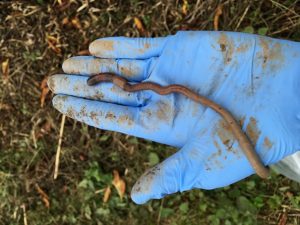
By Jeremy Lelean, Geography and Environmental Science, University of Reading
Soil, from being an overlooked area of research, is now considered an area of vital interest in the solution to many of the global problems of we currently face. A key idea of how to manage our soil is the notion of soil health, which was referred to regularly in the newly published DEFRA Twenty-Five Year Environment Plan.
Measuring soil health, however, is a vexed question as there are a number of potential indicators that can be used. One of these is earthworm numbers, but numbers alone may not give a good picture of soil health overall. As part of the Soil Security Programme, fellow Dr Jackie Stroud has developed a method that is more indicative of soil health than simple earthworm numbers.
60 Minute Worms is a tracker with a traffic-light rating system to signal healthy soil management practices. The assessment involves digging 10 spade-size topsoil pits, then sorting and identifying the three types of earthworms (epigeic, endogeic and anecic). The results reveal the likelihood of earthworm function in your soils, rated from red (unlikely) to orange (possible) to green (likely).

Tillage intensity, crop rotation and organic matter applications all influence earthworm communities in arable soils. 60 Minute Worms shows how land management decisions above the ground influence the millions of earthworms that are engineering the soil ecosystem below.
By taking part in 60 Minute Worms, practitioners can see how their field ranks for earthworms, individual results can be compared as part of a national survey, and as a community, they can help improve the likelihood of benefiting from earthworm function in agriculture.
This fits into the wider work of the Soil Security Programme in making sure that soil function is better understood. For example, the work Dr John Hammond, in the University of Reading’s School of Agriculture, Policy and Development, is carrying out into phosphorus cycling and the role microbes living in the soil play in this essential process.
Another key role of the Soil Security Programme is to ensure research is communicated to end users whether through larger bodies or influencing individual practitioners through projects like Jackie’s.
Earthworms keep our songbirds singing in the spring, and their burrowing activities literally shape the ground beneath our feet. In addition, now, they can tell us how healthy that ground is.
